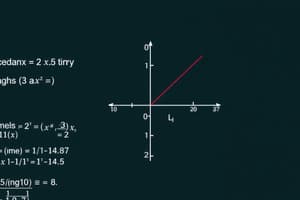Podcast
Questions and Answers
What is the absolute value?
What is the absolute value?
- The product of a number with itself
- The sum of two numbers
- The distance of a number from zero on a number line (correct)
- The opposite of a number
What is the additive inverse of a?
What is the additive inverse of a?
-a
What does cubed mean?
What does cubed mean?
Any expression taken to the third power
What is an exponent?
What is an exponent?
What are integers?
What are integers?
What are opposites?
What are opposites?
What is scientific notation?
What is scientific notation?
What does squared mean?
What does squared mean?
What is subtraction?
What is subtraction?
What is a variable?
What is a variable?
What is zero power?
What is zero power?
What is an addend?
What is an addend?
What is a minuend?
What is a minuend?
What is a subtrahend?
What is a subtrahend?
What is a dividend?
What is a dividend?
What is a divisor?
What is a divisor?
What is a quotient?
What is a quotient?
What is the base in exponential notation?
What is the base in exponential notation?
What is a negative exponent?
What is a negative exponent?
What is one method for adding integers with like signs?
What is one method for adding integers with like signs?
What is one method for adding integers with unlike signs?
What is one method for adding integers with unlike signs?
What is the Multiplication Property of Exponents?
What is the Multiplication Property of Exponents?
What is the Power Property of Exponents?
What is the Power Property of Exponents?
What is the Division Property of Exponents?
What is the Division Property of Exponents?
What are the first two steps in the Order of Operations?
What are the first two steps in the Order of Operations?
Flashcards are hidden until you start studying
Study Notes
Mathematical Concepts and Definitions
- Absolute value: Measures the distance of a number from zero on a number line; always non-negative.
- Additive inverse: For any number 'a', 'b' is its additive inverse if a + b = 0; represented as -a.
- Cubed: Refers to raising any expression to the third power.
- Exponent: A superscript showing how many times the base is multiplied by itself.
- Integers: Include all whole numbers and their negatives; extend infinitely in both directions.
- Opposites: Numbers located an equal distance from zero but in opposite directions; examples include 5 and -5.
- Scientific notation: Format that expresses numbers as a product of a number between 1 and 10 and a power of ten.
- Squared: Indicates a number or expression multiplied by itself, represented by an exponent of two.
Arithmetic Operations and Properties
- Subtraction: Can be viewed as adding an opposite; for instance, a - b is equivalent to a + (-b).
- Variable: A symbol (usually a letter) that represents an unknown quantity in expressions or equations.
- Zero power: States that any non-zero number raised to the power of zero results in 1.
- Addend: Any number involved in an addition operation; e.g., in 3 + 5, both 3 and 5 are addends.
- Minuend: The number from which another is subtracted in a subtraction operation.
- Subtrahend: The number being subtracted from the minuend in a subtraction operation.
- Dividend: The quantity being divided in a division operation.
- Divisor: The number by which another number (the dividend) is divided.
- Quotient: The result of a division operation.
Exponents and Their Properties
- Base: The number that is raised to a power in exponential form and also indicates place values in a numeral system.
- Negative exponent: If 'x' is a non-zero number and 'a' is an integer, then x^-a = 1/x^a, reflecting division.
Operations with Integers
- Adding integers with like signs: Sum the absolute values and apply the common sign for the result.
- Adding integers with unlike signs: Compute the difference in absolute values and adopt the sign of the number with the larger absolute value.
Properties of Exponents
- Multiplication Property of Exponents: States that when multiplying like bases, add their exponents: x^a * x^b = x^(a+b).
- Power Property of Exponents: When raising a power to another power, multiply the exponents: (x^a)^b = x^(ab).
- Division Property of Exponents: Describes how to handle division with exponents.
Order of Operations
- Order of Operations: A set sequence to solve mathematical expressions:
- Evaluate grouping symbols first.
- Compute all exponents.
- Perform multiplication and division from left to right.
- Conduct addition and subtraction from left to right.
Studying That Suits You
Use AI to generate personalized quizzes and flashcards to suit your learning preferences.




